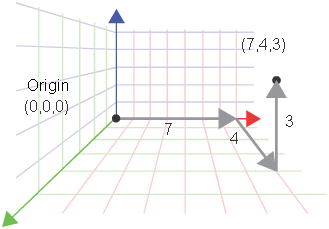A point is a location defined by three spatial coordinates. It has no size.
The most basic visual entity is the point. The point has no size, but it has a location.
To determine the location of points, we first establish an arbitrary point in space as the origin.
We can then say that the location of a point is so many units left (or right) of the origin, so many units up (or down) from the origin, and so many units higher (or lower) than the origin.

These three numbers give us the 3D coordinates of the point in space. For example, a point 7 units right, 4 units down, and 3 units above the origin has the 3D coordinates (7,4,3).
To specify points on the opposite side of the origin, we use negative numbers. In the following example, a point at (-5, -2, -1) would be 5 units left of the origin, 2 units up, and 1 unit.

In computer graphics, we don’t really say that the point is “left/right”, “up/down”, or “higher/lower”. Instead we call the three dimensions the X axis, the Y axis, and the Z axis.